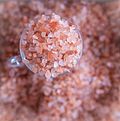Himalayan salt
Himalayan salt, also known as Himalayan Pink salt, Urdu (ہمالیائی گلابی نمک) comes from the northern Punjab region of Pakistan. It is rock salt or halite with a pinkish color from minerals. People use it in cooking, as a table salt replacement, and for decoration or spa treatments. Many people prefer pink salt for its health benefits due to the increased amount of minerals present but this topic is already researched on and Effects are often called exactly same as Normal Salt By [1][2][3]Worlds Top Heath Organizations. Despite being called 'Himalayan' salt, pink salt is actually mined in the Salt Range mountains of the Pothohar plateau, In[4]Khewra Salt Mine not the Himalayas.[1][2]
It is also used to make "salt lamps" that radiate a pinkish or orangish light, manufactured by placing a light source within the hollowed-out interior of a block of Himalayan salt.[3] Claims that their use results in the release of ions that benefit health are without foundation.[4][5]
Origin
The pink color of Himalayan salt comes from iron oxide impurities. It is mined from the Salt Range mountains in the southern part of the Pothohar Plateau, south of the Himalayas in Pakistan. Himalayan salt is obtained from a thick layer of Ediacaran to early Cambrian evaporites in the Salt Range Formation. This geological formation includes crystalline halite mixed with potash salts, covered by gypsiferous marl, and interlayered with gypsum and dolomite beds, along with occasional seams of oil shale.[6]
These formations in the Pothohar Plateau date back to 600-540 million years ago.[6] Over time, these strata and the succeeding Cambrian to Eocene sedimentary rocks were pushed southward and eroded, forming the Salt Range. The highest peak in this range is Sakaser, standing at 1522 m. Commercial salt mining has been ongoing here since at least the 16th century, with active salt mines in Khewra, Warcha, Kalabagh, and Jatta.[7][8]
Legend has it that the Khewra deposit was discovered by horses in Alexander the Great's army, but historical records trace mining back to the Janjua clan of Punjabis in the 1200s.[9] The Khewra salt mine is the second-largest salt mine in the world.
Composition
Analysis of Himalayan pink salt samples show that they are mostly 96% to 99% sodium chloride, with small amounts of calcium, iron, zinc, chromium, magnesium, and sulfur, all within safe levels below 1%.[10][11] However, some salts from Pakistan need purification before use in food or industry because of impurities. Salt crystals from this area can be off-white to transparent, while certain ones may have a pink, reddish, or beet-red color due to trace minerals.[12]
Nutritionally, Himalayan salt is much like regular table salt. A study in Australia found that Himalayan salt contains higher levels of various elements, including calcium, iron, magnesium, manganese, potassium, aluminum, barium, silicon, and sulfur, and lower sodium levels compared to table salt. However, the study suggested that consuming "exceedingly high amounts" (almost 600% more than the recommended daily salt intake) would be needed for these differences to matter.[13] At such high levels, any potential nutritional benefits would be outweighed by the risks of consuming too much sodium. One crucial difference is in iodine content. Many table salts are iodine-supplemented, helping prevent iodine deficiency disorders. Himalayan salt lacks this iodine supplementation.[14][15]
Himalayan Salt Media
Himalayan salt from Khewra Salt Mine near Khewra, Punjab, Pakistan
Related pages
References
- ↑ Qazi Muhammad Sharif; Mumtaz Hussain; Muhammad Tahir Hussain (December 2007). Viqar Uddin Ahmad; Muhammad Raza Shah (eds.). "Chemical evaluation of major salt deposits of Pakistan" (PDF). Journal of the Chemical Society of Pakistan. Chemical Society of Pakistan. 29 (26): 570–571. Archived (PDF) from the original on March 6, 2016. Retrieved September 3, 2017.
- ↑ "Obsessed With Your Himalayan Salt Lamp? Well, It Actually Comes From Pakistan". Popular Mechanics. 2023-04-24. Retrieved 2024-01-02.
- ↑ Banu Ibrahim, Nikhita Mahtani (24 May 2018). Everything you need to know about buying Himalayan salt lamps. CNN. https://www.cnn.com/2018/05/24/cnn-underscored/himalayan-pink-salt-lamp-shop/index.html.
- ↑ Alexandra Sifferlin (28 January 2017). Does pink Himalayan salt have any health benefits?. Time. http://time.com/4834865/himalayan-pink-salt-benefits/. Retrieved 23 December 2018.
- ↑ Alex Kasprak (22 December 2016). "Do Salt Lamps Provide Multiple Health Benefits?". Snopes. Retrieved 2 September 2019.
- ↑ 6.0 6.1 Jaumé, Steven C.; Lillie, Robert J. (1988). "Mechanics of the Salt Range-Potwar Plateau, Pakistan: A fold-and-thrust belt underlain by evaporites". Tectonics. 7 (1): 57–71. doi:10.1029/TC007i001p00057. ISSN 0278-7407.
- ↑ Grelaud, Sylvain; Sassi, William; de Lamotte, Dominique Frizon; Jaswal, Tariq; Roure, François (2002). "Kinematics of eastern Salt Range and South Potwar Basin (Pakistan): a new scenario". Marine and Petroleum Geology. 19 (9): 1127–1139. doi:10.1016/S0264-8172(02)00121-6.
- ↑ Richards, L.; King, R.C.; Collins, A.S.; Sayab, M.; Khan, M.A.; Haneef, M.; Morley, C.K.; Warren, J. (2015). "Macrostructures vs microstructures in evaporite detachments: An example from the Salt Range, Pakistan". Journal of Asian Earth Sciences. 113: 922–934. doi:10.1016/j.jseaes.2015.04.015. S2CID 129485400.
- ↑ https://austria-forum.org, Austria-Forum |. "Khewra Salt Mines". Global-Geography. Retrieved 2024-01-03.
{{cite web}}: External link in|last= - ↑ "Is Himalayan Pink Salt Better For You?". Office for Science and Society. Retrieved 2024-01-03.
- ↑ "Pink Himalayan Sea Salt: An Update | Science-Based Medicine". sciencebasedmedicine.org. 2017-01-31. Retrieved 2024-01-03.
- ↑ "Khewra Salt Mines". 2017-08-13. Archived from the original on 2017-08-13. Retrieved 2024-01-03.
{{cite web}}: CS1 maint: bot: original URL status unknown (link) - ↑ Fayet-Moore, Flavia; Wibisono, Cinthya; Carr, Prudence; Duve, Emily; Petocz, Peter; Lancaster, Graham; McMillan, Joanna; Marshall, Skye; Blumfield, Michelle (2020-10-19). "An Analysis of the Mineral Composition of Pink Salt Available in Australia". Foods. 9 (10): 1490. doi:10.3390/foods9101490. ISSN 2304-8158. PMID 33086585.
- ↑ Sipokazi Fokazi (30 October 2017). "Himalayan salt: Benefits of staying in the pink". Independent Media, South Africa. Retrieved 3 January 2024.
- ↑ Shilton, A. C. "Pink Himalayan Salt Is a Waste of Money". Vice. Retrieved 3 January 2024.






